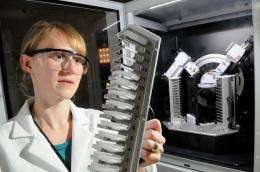New materials engineering labs see early success

(�鶹��ԺOrg.com) -- After only a few months of work, a small group of researchers at the U.S. Department of Energy's (DOE) Argonne National Laboratory has successfully scaled up the production of a new molecule that protects advanced lithium-ion batteries from thermal overcharge.
When Argonne materials scientist Khalil Amine and chemists Zhengcheng Zhang and Lu Zhang invented a redox shuttle additive material known as 2,5-di-tert-butyl-1,4-bis(2-methoxyethoxy)benzene or DBBB, the amount of the molecule they produced was sufficient for scientific testing and validation at the laboratory bench scale. But their process yielded too little material—less than 1 gram—for a company that may be interested in licensing and manufacturing the material to validate and test.
Applied researchers in Argonne’s Advanced Battery Materials Synthesis and Manufacturing Research & Development Program took the formula and developed an improved, scalable process that created 1,576 grams in a single batch—enough to study and validate in a real battery cell, said Argonne's Greg Krumdick, a systems engineer whose team developed the scale-up process.
Scientists typically do not need large amounts of materials to work with, but companies that want to manufacture a new material do. And therein lay the challenge—it is critical for companies to test the viability of a new material they are looking to mass produce.
However, the scale-up of a specialty material like DBBB is no small feat. Unlike the doubling or tripling of a cake recipe, it is not a matter of multiplying the amount of a chemical formulation by 1,000 or 10,000 or more to make larger quantities of a molecule.
Other considerations—like time, temperature, concentration, mixing speeds and even the chemical ingredients themselves—that do not come up when making very small amounts of a material arise when attempting to make vastly larger volumes for commercial testing and mass market production.
"Unless you have a process to make a material in sufficient quantities, you simply can't get enough of the material," Krumdick said. "It is often wrongly assumed that industry will do the scale-up work, but most companies don't want to make the significant financial investment required to develop the scale-up process. It's too risky, especially if you don’t know if it will be economical to make the material at scale."
That is where the process engineering and scale-up expertise and facilities of Argonne’s federally funded Advanced Battery Materials Synthesis and Manufacturing Research & Development Program are brought to bear.
The goal of process scale up is to find economical ways to make a material. The bench scale process used to discover DBBB would have cost 20 times more and generated 50 times as much waste as the scaled up process to make 1 kilogram. The new process also is 3 times faster.
However, it was never intended to use the bench scale process to make commercial quantities of materials, Krumdick said. "When discovering new materials, it’s not your objective to be sure it is made economical; it’s to make it quickly. Once a new material has been discovered and is shown to have promise, it’s my group’s job to scale it up, meaning find economical ways to make large volumes of the materials.
"After finishing work on DBBB, we had made a kilogram scale batch that was chemically analyzed and its electrochemical performance characterized and was found to be identical to the initial material synthesized. The new process is also highly reproducible in yield and purity from batch to batch."
Krumdick worked with Krzystof Pupek and Trevor Dzwiniel—both of who came from the pharmaceutical industry, which routinely develops scale-up processes—to scale-up DBBB at the Material Engineering Facility (MEF), where the scale-up work was done.
DOE invested $5.8 million from the American Recovery and Reinvestment Act to help fund MEF's construction to help close the lag time between innovation and commercialization. The U.S. Department of Defense (DoD) provided another $4 million toward MEF construction.
DoD is also interested in Argonne’s battery research. According to the assistant secretary of defense, Sharon Burk, the average U.S. soldier on a 72 hour patrol carries between 10 and 20 pounds of batteries.”You can follow a U.S. infantry patrol by the disposable batteries that it trails behind it,” Army Chief of Staff General Martin Dempsey told an Institute of Land Warfare breakfast in May. "At the highest levels, there appears to be recognition of the inadequacy of disposable batteries”.
The military uses batteries in a wide range of electronics, including the electronics systems in tanks, which would be able to remain in the field longer and without detection if some of its systems were run on batteries.
The MEF is not yet fully constructed. The facility is expected to be completed in January and will contain three pilot labs and high-bays for continuous batch production of large volumes—up to 100 kilograms—of specialty materials for industry validation, said Krumdick, who oversees MEF construction.
Argonne plans make the MEF a quasi-user facility that will be accessible to other R&D organizations and companies, said Jeff Chamberlain, who leads Argonne's energy storage research initiative. The facility and the close teaming of scientists and engineers are part of a full-circle approach that Argonne employs to help industry move U.S. energy innovations into the marketplace more quickly.
“There are at least two battery manufacturers interested in the DBBB redox shuttle,” Chamberlain said. “I believe that the success that Greg and his team have had in scaling up production of the material will allow Argonne to significantly shrink the time between product innovation and commercial licensing and manufacturing. Not only will the payback to the taxpayer’s investment in R&D be shortened, but innovation’s contribution to the growth of the U.S. economy will be realized that much sooner.”
Provided by Argonne National Laboratory



















